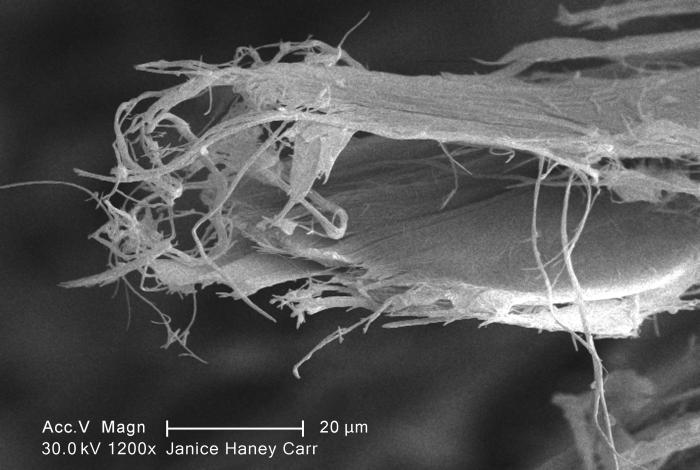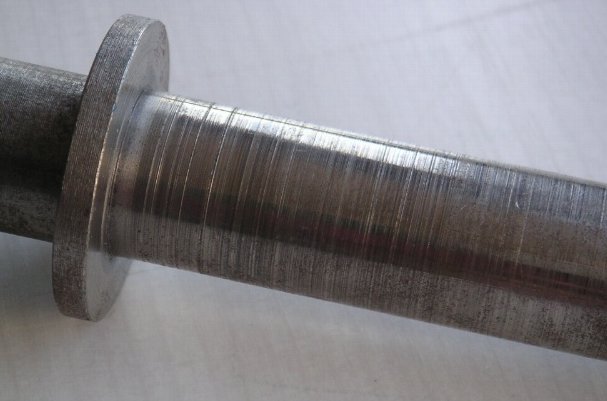|
Zetex (fabric)
Zetex fabrics were invented by Bal Dixit in 1978. This highly texturized fiberglass fabric exhibits many of the same properties as asbestos, such as resistance to heat, corrosion and rot resistance, outstanding electrical properties, ability to withstand molten metal, and thermal insulation. However, it does not carry the same health risks. Testing Zetex has been tested against asbestos to prove it is a good replacement. Two Zetex filaments were created, one with a 9 um diameter (G) and a 6 um diameter (DE). Physical Properties Chrysotile, the most commonly encountered form of asbestos, has a density of 40 oz/yd2, while Zetex G has a density of 35 oz/yd2, and Zetex DE has a density of 32 oz/yd2. Other physical properties are listed in the table below: Temperature rise testing A glove was fabricated from this material to allow for further testing to be done. A thermocouple was used to test the inside temperature of the glove while holding a 600°F(316°C) pipe. A measure was ta ... [...More Info...] [...Related Items...] OR: [Wikipedia] [Google] [Baidu] |
Bal Dixit
Bal Dixit is the chairman of Newtex Industries. He founded Newtex in 1978 after being one of the first researchers to formulate a viable alternative to asbestos in fire safety gear. In 1977, he started work on developing a product he would later call Zetex in response to the impending asbestos ban. This product exhibits many of the properties of asbestos, without the side effects of lung cancer or mesothelioma. Early life and education Dixit was born in the village of Katol in central India in 1938. After receiving his degree in Textile Technology from the University of Punjab, he emigrated to the United States in 1964, joining Union Carbide Corporation as an Advanced Technologist. At Union Carbide, Dixit helped develop carbon fiber for lightweight structural composites that were later incorporated in General Dynamics' F-111B fighter aircraft. Dixit earned his master's in Textile Technology from the University of Massachusetts in 1966 and soon after joined Garlock, where he was ta ... [...More Info...] [...Related Items...] OR: [Wikipedia] [Google] [Baidu] |
Fiberglass
Fiberglass (American English) or fibreglass (Commonwealth English) is a common type of fiber-reinforced plastic using glass fiber. The fibers may be randomly arranged, flattened into a sheet called a chopped strand mat, or woven into glass cloth. The plastic matrix may be a thermoset polymer matrix—most often based on thermosetting polymers such as epoxy, polyester resin, or vinyl ester resin—or a thermoplastic. Cheaper and more flexible than carbon fiber, it is stronger than many metals by weight, non- magnetic, non-conductive, transparent to electromagnetic radiation, can be molded into complex shapes, and is chemically inert under many circumstances. Applications include aircraft, boats, automobiles, bath tubs and enclosures, swimming pools, hot tubs, septic tanks, water tanks, roofing, pipes, cladding, orthopedic casts, surfboards, and external door skins. Other common names for fiberglass are glass-reinforced plastic (GRP), glass-fiber reinforced plastic (GFRP) or GF ... [...More Info...] [...Related Items...] OR: [Wikipedia] [Google] [Baidu] |
Asbestos
Asbestos () is a naturally occurring fibrous silicate mineral. There are six types, all of which are composed of long and thin fibrous crystals, each fibre being composed of many microscopic "fibrils" that can be released into the atmosphere by abrasion and other processes. Inhalation of asbestos fibres can lead to various dangerous lung conditions, including mesothelioma, asbestosis, and lung cancer, so it is now notorious as a serious health and safety hazard. Archaeological studies have found evidence of asbestos being used as far back as the Stone Age to strengthen ceramic pots, but large-scale mining began at the end of the 19th century when manufacturers and builders began using asbestos for its desirable physical properties. Asbestos is an excellent electrical insulator and is highly fire-resistant, so for much of the 20th century it was very commonly used across the world as a building material, until its adverse effects on human health were more widely acknowledged ... [...More Info...] [...Related Items...] OR: [Wikipedia] [Google] [Baidu] |
Chrysotile
Chrysotile or white asbestos is the most commonly encountered form of asbestos, accounting for approximately 95% of the asbestos in the United StatesOccupational Safety and Health Administration, U.S. Department of Labor (2007)29 C.F.R. 1910.1001 Appendix J. and a similar proportion in other countries.Institut national de recherche sur la sécurité (1997).Amiante." ''Fiches toxicologiques.'' n° 167. (in French) It is a soft, fibrous silicate mineral in the serpentine subgroup of phyllosilicates; as such, it is distinct from other asbestiform minerals in the amphibole group. Its idealized chemical formula is Mg( Si O)( OH). The material has physical properties which make it desirable for inclusion in building materials, but poses serious health risks when dispersed into air and inhaled. Polytypes Three polytypes of chrysotile are known. These are very difficult to distinguish in hand specimens, and polarized light microscopy must normally be used. Some older publica ... [...More Info...] [...Related Items...] OR: [Wikipedia] [Google] [Baidu] |
Asbestos
Asbestos () is a naturally occurring fibrous silicate mineral. There are six types, all of which are composed of long and thin fibrous crystals, each fibre being composed of many microscopic "fibrils" that can be released into the atmosphere by abrasion and other processes. Inhalation of asbestos fibres can lead to various dangerous lung conditions, including mesothelioma, asbestosis, and lung cancer, so it is now notorious as a serious health and safety hazard. Archaeological studies have found evidence of asbestos being used as far back as the Stone Age to strengthen ceramic pots, but large-scale mining began at the end of the 19th century when manufacturers and builders began using asbestos for its desirable physical properties. Asbestos is an excellent electrical insulator and is highly fire-resistant, so for much of the 20th century it was very commonly used across the world as a building material, until its adverse effects on human health were more widely acknowledged ... [...More Info...] [...Related Items...] OR: [Wikipedia] [Google] [Baidu] |
Abrasion (mechanical)
Abrasion is the process of scuffing, scratching, wearing down, marring, or rubbing away. It can be intentionally imposed in a controlled process using an abrasive. Abrasion can be an undesirable effect of exposure to normal use or exposure to the elements. In stone shaping Ancient artists, working in stone, used abrasion to create sculptures. The artist selected dense stones like carbonite and emery and rubbed them consistently against comparatively softer stones like limestone and granite. The artist used different sizes and shapes of abrasives, or turned them in various ways as they rubbed, to create effects on the softer stone's surface. Water was continuously poured over the surface to carry away particles. Abrasive technique in stone shaping was a long, tedious process that, with patience, resulted in eternal works of art in stone. Models The Archard equation is a simple model used to describe sliding wear and is based on the theory of asperity contact. Q = \frac H whe ... [...More Info...] [...Related Items...] OR: [Wikipedia] [Google] [Baidu] |
Expansion Joints
An expansion joint, or movement joint, is an assembly designed to hold parts together while safely absorbing temperature-induced expansion and contraction of building materials, and vibration, or to allow movement due to ground settlement or seismic activity. They are commonly found between sections of buildings, bridges, sidewalks, railway tracks, piping systems, ships, and other structures. Building faces, concrete slabs, and pipelines expand and contract due to warming and cooling from seasonal variation, or due to other heat sources. Before expansion joint gaps were built into these structures, they would crack under the stress induced. Bridge expansion joints Bridge expansion joints are designed to allow for continuous traffic between structures while accommodating movement, shrinkage, and temperature variations on reinforced and prestressed concrete, composite, and steel structures. They stop the bridge from bending out of place in extreme conditions, and also allow eno ... [...More Info...] [...Related Items...] OR: [Wikipedia] [Google] [Baidu] |
Fire Proximity Suit
A fire proximity suit (also, silvers, silver bunker suit, or asbestos suit) is a suit designed to protect a firefighter or volcanologist from extremely high temperatures. They were first designed and used in the 1930s. Originally made of asbestos fabric, current models use vacuum-deposited aluminized materials. History Fire proximity suits first appeared during the 1930s, and were originally made of asbestos fabric. Today they are manufactured from vacuum-deposited aluminized materials that reflect the high radiant loads produced by the fire. An early manufacturer of the aluminized suits was the Bristol Uniforms company under of Patrick Seager Hill. Types There are three basic types of these aluminized suits: * Approach suit—used for work in the general area of high temperatures such as steel mills and smelting facilities. These usually provide ambient heat protection up to ≈. * Proximity suit—used for aircraft rescue and fire fighting (AR-FF) and, in more heavily ... [...More Info...] [...Related Items...] OR: [Wikipedia] [Google] [Baidu] |
Glassblower
Glassblowing is a glassforming technique that involves inflating molten glass into a bubble (or parison) with the aid of a blowpipe (or blow tube). A person who blows glass is called a ''glassblower'', ''glassmith'', or ''gaffer''. A '' lampworker'' (often also called a glassblower or glassworker) manipulates glass with the use of a torch on a smaller scale, such as in producing precision laboratory glassware out of borosilicate glass. Technology Principles As a novel glass forming technique created in the middle of the 1st century BC, glassblowing exploited a working property of glass that was previously unknown to glassworkers; inflation, which is the expansion of a molten blob of glass by introducing a small amount of air into it. That is based on the liquid structure of glass where the atoms are held together by strong chemical bonds in a disordered and random network,Frank, S 1982. Glass and Archaeology. Academic Press: London. Freestone, I. (1991). "Looking into Glass". ... [...More Info...] [...Related Items...] OR: [Wikipedia] [Google] [Baidu] |







